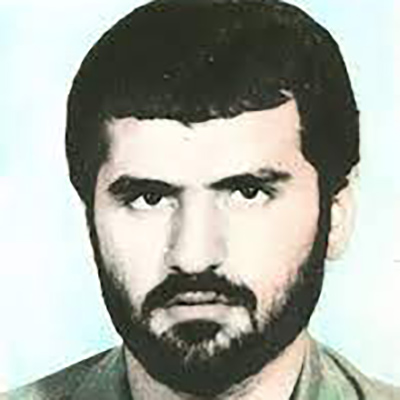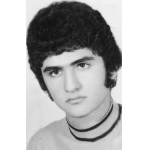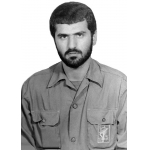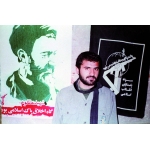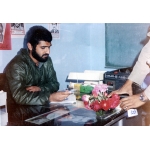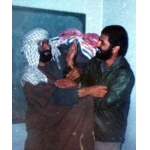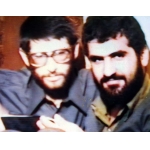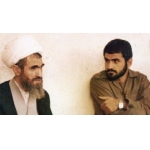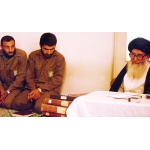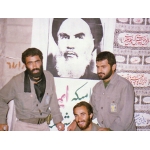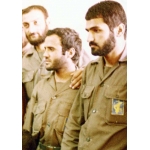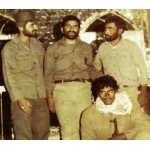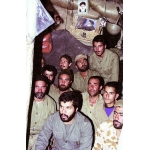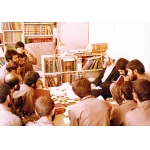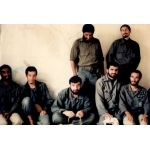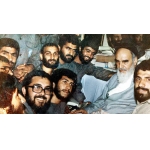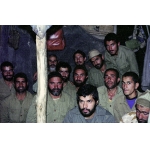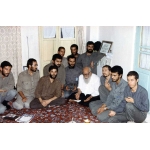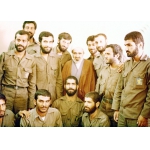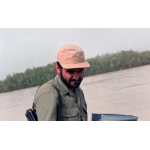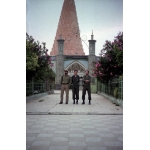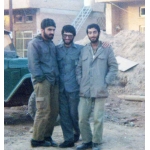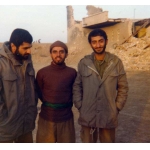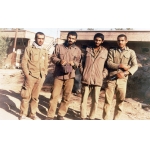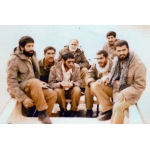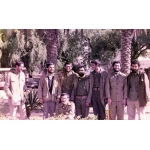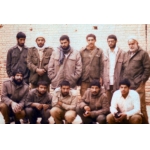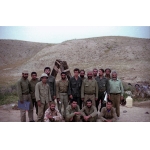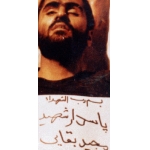People
Baqaei, Majid
Zeinab Ahmadi
180 Views
Majid Baqaei, the commander of the Karbala Headquarters of the Islamic Revolutionary Guard Corps (IRGC), was martyred in 1982 during Operation Preliminary Valfajr in Fakkeh.
Majid Baqaei was born in early 1959 in Behbahan (Khuzestan) and obtained his diploma from Pahlavi (Motahari) High School. In 1974-1975, he was admitted to the Jundi Shapur Medical University of Ahvaz (Dr. Chamran). It was during this time that he began his political activities against the Pahlavi regime.[1]
In 1975, Baqaei joined the military branch of the Mansouroun Group, which secretly pursued an armed struggle against the Pahlavi regime, participating in some of its armed urban guerrilla operations.[2] Majid Baqaei[3] undertook guerrilla and military training around Behbahan, along with some of his like-minded friends, formed a group that facilitated holding protests and demonstrations against the Pahlavi regime by throwing stones, burning tires, and similar actions. He also organized patrols in Behbahan after the victory of the Islamic Revolution to prevent anti-revolutionary actions by the Shah-backed club-wielders.[4]
After the victory of the Islamic Revolution, Baqaei joined the Islamic Revolutionary Committee and the Behbahan Shahrbani (police). He later worked in the Ahvaz Revolutionary Court, where, alongside Muhammad-Ali Jahanara, commander of the Khorramshahr IRGC, fought against the Arab Separatist Group, which sought to divide Iran. He also established the Center for Islamic Culture in Behbahan,[5] utilizing his skills and enthusiasm for propagational efforts such as designing posters, recording speeches, producing video films, painting, and calligraphy. He organized an exhibition in Behbahan showcasing the crimes committed by the Pahlavi regime and SAVAK documents. As a designer and calligrapher, he would write sayings of the Ahl al-Bayt (as) and post them on city walls.[6]
Following Imam Khomeini’s decree to establish the Jihad of Construction Organization, Baqaei joined the Behbahan branch of the organization in 1979.[7]
With the onset of the imposed war by Iraq against Iran, Baqaei joined the IRGC and worked in the public relations department of the Omidieh IRGC. Alongside Ismail Daqayeqi (martyred), he was serving in the Coordination, Research, and Inspection Office of the Khuzestan IRGC. Also, in 1980, he was the IRGC representative in the War Room of the 92nd Armored Division of Khuzestan of the Islamic Republic of Iran Army.[8]
By early 1981, Baqaei was appointed commander of the Shush IRGC. He first organized local forces and established connections with the Army, particularly the 21st Hamzeh Division.
On April 14, 1981, Operation Imam Mahdi (as) was designed and executed under Baqaei’s command in the Sheleibieh to recapture occupied territories (from Raqabiyeh Strait to Shush). Before the operation, he realized that the enemy could destroy all Iranian positions with just a few helicopters. Therefore, by coordinating with officials leading the Hamidiyeh front in Susangerd, he managed to deploy TOW missiles in Shush. The Iraqi army, which had advanced to Karkheh, retreated upon the first missile strike on a helicopter, enabling Iranian forces to construct a bridge over Karkheh.[9]
In the fall of 1981, Baqaei handed over the command of the Shush IRGC[10] and on November 29, 1981,[11] participated as an ordinary IRGC soldier in Operation Tariq al-Quds. His battalion was besieged by Iraqis near the Nissan River in Susangerd for three days before being rescued.[12]
Before Operation Fath al-Mobin, the IRGC commander Mohsen Rezaei assigned Baqaei as the commander of Fajr Headquarters in Shush.[13] On March 22, 1982, he participated in Operation Fath al-Mobin[14] playing a key role in planning and leading combat units to liberate Abu Slaibi Khatt Heights.[15] Following this operation, he was entrusted with managing the defensive line of the region. Through reconnaissance with Hassan Baqeri, deputy commander of the IRGC Ground Forces, the plan for Operation Beit al-Muqaddas was developed to liberate Khorramshahr and threaten Iraq’s ports in Basra.[16]
On April 30, 1982,[17] simultaneously with the first phase of Operation Beit al-Muqaddas, a diversionary operation, known as Operation 182, was conducted in the Channaneh to Fakkeh front to capture the 182 Heights. Fajr Headquarters, commanded by Baqaei, consisting of the 17th Qom Brigade, the 33rd Al-Mahdi (as) Brigade, and the 34th Imam Sajjad (as) Brigade, participated in the operation, successfully capturing the Height.[18] Later on, the three brigades, under Baqaei’s command, were deployed to Khorramshahr to support other units.[19]
On July 13, 1982, Baqaei, as the commander of Fajr Division Headquarters, participated in Operation Ramadan in which the 17th Qom Brigade managed to capture Zaid Outpost.[20] A few months later, he was appointed as the deputy to Hassan Baqeri at Karbala Headquarters and took command of the First Corps of Karbala after Operation Muharram.[21] On January 29, 1983, the vehicle carrying Majid Baqaei, Hassan Baqeri, and several other commanders was struck by Iraqi mortar fire while conducting a reconnaissance mission in the Operation Preliminary Valfajr zone, leading to their martyrdom.[22] The next day, after holding a funeral in Ahvaz the body of Majid Baqaei was transported to Behbahan,[23] where he was buried in Shahidabad Cemetery.[24] Also, a memorial service was held for him and other martyred commanders at Shahid Motahari High School in Tehran.[25]
In 1989, the Leader of the Islamic Revolution awarded the second-degree Fath Medal to Martyr Majid Baqaei’s family.[26] The book Yaddashthai-e Farmandeh (Commander’s Notes) is a collection of the daily notes of Major General Majid Baqaei, written in 1982 when he was commanding the Karbala Headquarters.[27] A hospital in Ahvaz is named after him,[28] and in 2012, a congress was held in Tehran in his honor.[29]
[1] Salari, Azizollah, Ta Cheshmeh Baqa (To the Spring of Eternity), Tehran, Niloufaran, 2009, p. 181.
[2] Samadi, Muhammad Ali, Setaregan-e Aseman-e Gomnami (Stars of the Anonymous Sky), Tehran, Farhangsara Andisheh, 1999, p. 29.
[3] Vahed-e Tadvin-e Tarikh Enqelab Eslami (Islamic Revolution History Compilation Unit), Daera al-Maaref Enqelab Eslami (Encyclopedia of the Islamic Revolution), Vol. 3, Tehran, Soore Mehr, 2015, p. 360.
[4] Samadi, Muhammad Ali, ibid., p. 31.
[5] Ibid., p. 33.
[6] Wiki Shahid website: https://wikishahid.ir/%D9%85%D8%AC%DB%8C%D8%AF_%D8%A8%D.
[7] Samadi, Muhammad Ali, ibid., p. 33.
[8] Ibid., p. 36; Salari, Azizollah, ibid., Pp. 183-184.
[9] Moassesseh Farhangi-Honari Jannat Fakkeh, Baad az Eshq (After the Love), Tehran, Jannat Fakkeh, 2012, Pp. 27, 50.
[10] Ibid., p. 50.
[11] Rashid, Mohsen, Atlas-e Jang-e Iran va Iraq (Atlas of the Iran-Iraq War), Tehran, Markaz-e Tahqiqat Sepah-e Pasdaran, 2010, p. 47.
[12] Moassesseh Farhangi-Honari Jannat Fakkeh, ibid., p. 36.
[13] Ibid., p. 135.
[14] Samadi, Muhammad Ali, ibid., p. 36.
[15] Wiki Shahid website.
[16] Samadi, Muhammad Ali, ibid., Pp. 36-37.
[17] Rashid, Mohsen, ibid., p. 49.
[18] Moassesseh Farhangi-Honari Jannat Fakkeh, ibid., Pp. 135, 50-51.
[19] Ibid., p. 135.
[20] Ibid., p. 136.
[21] Ibid., Pp. 136-137; Samadi, Muhammad Ali, ibid., Pp. 39, 42.
[22] Ibid. and Yadegari Sardaran (A Memory of the Commanders), p. 42.
[23] Rooznameh Ettelaat (Ettelaat Newspaper), No. 16931, 11 Bahman 1361, p. 4.
[24] Rooznameh Jomhouri Eslami (Jomhouri Eslami Newspaper), No. 1065, 11 Bahman 1361, p. 4.
[25] Rooznameh Ettelaat (Ettelaat Newspaper), No. 16934, 14 Bahman 1361, p. 2.
[26] Rooznameh Jomhouri Eslami (Jomhouri Eslami Newspaper), No. 2993, 6 Mehr 1368, p. 12.
[27] Baghaei, Majid, Yaddashthai-e Farmandeh (Commander’s Notes), Tehran, Moassesseh Farhangi-Honari Jannat Fakkeh, 1391, p. 7.
[28] Pourjabari, Pejman, Atlas-e Joghrafiye Hamasi 1: Khuzestan dar Jang (Epic Geography Atlas 1: Khuzestan in the War), Tehran, Sarir, 1389, p. 193.
[29] Hamshahri Website, https://www.hamshahrionline.ir/news/199395.




